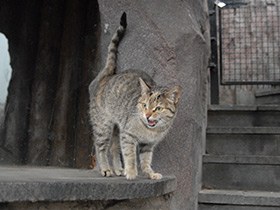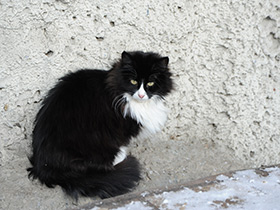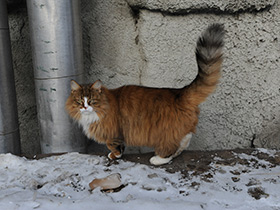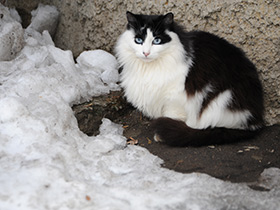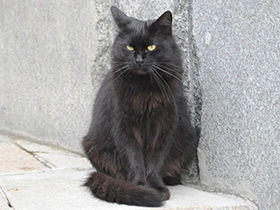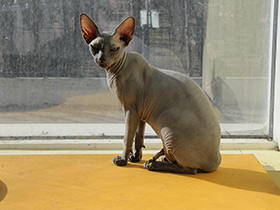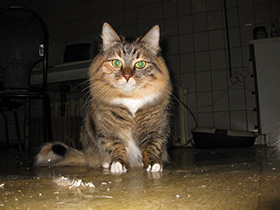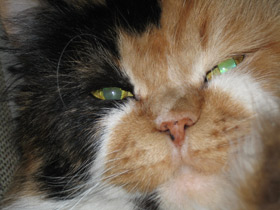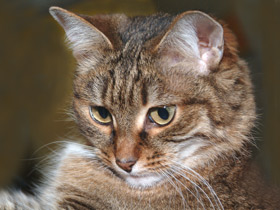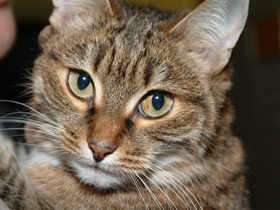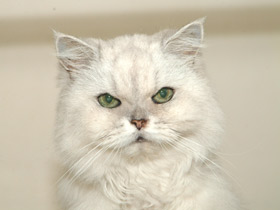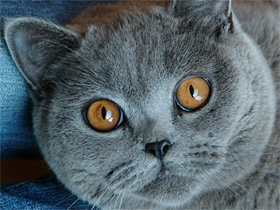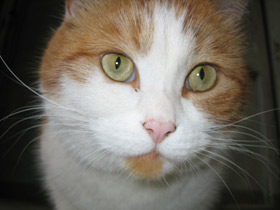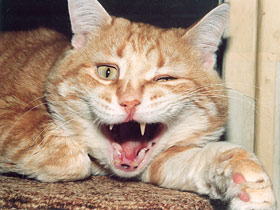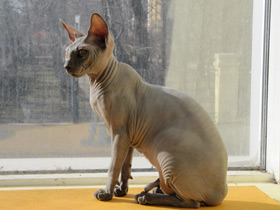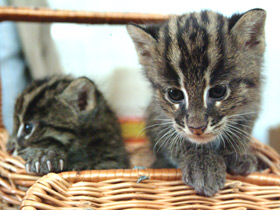The cat (Felis catus)
The cat (Felis catus), commonly referred to as the domestic cat or house cat, is the only domesticated species in the family Felidae.
The domestic cat is a carnivorous mammal of the family Felidae. It is a subspecies domesticated by coexistence with humans.
The current name in many languages comes from the Vulgar Latin catus. Paradoxically, Catus referred to wild cats, while domestic cats were called Felis.
Its ancestor is believed to be the wild forest cat Felis silvestris, which is very similar but somewhat larger. The cat was domesticated about 9,500 years ago in the Middle East, where one of the oldest civilisations arose with man's transition to a sedentary way of life. There are currently about 100 known breeds of Felis silvestris catus, ranging from long-haired to hairless. The colour of their fur is also very varied.
Etymology and naming
The origin of the English word cat, Old English catt, is thought to be the Late Latin word cattus, which was first used at the beginning of the 6th century. The Late Latin word may be derived from an unidentified African language. The Nubian word kaddîska 'wildcat' and Nobiin kadīs are possible sources or cognates. The Nubian word may be a loan from Arabic قَطّ qaṭṭ ~ قِطّ qiṭṭ.
However, it is "equally likely that the forms might derive from an ancient Germanic word, imported into Latin and thence to Greek and to Syriac and Arabic". The word may be derived from Germanic and Northern European languages, and ultimately be borrowed from Uralic, cf. Northern Sámi gáđfi, 'female stoat', and Hungarian hölgy, 'lady, female stoat'; from Proto-Uralic *käďwä, 'female (of a furred animal)'.
The English puss, extended as pussy and pussycat, is attested from the 16th century and may have been introduced from Dutch poes or from Low German puuskatte, related to Swedish kattepus, or Norwegian pus, pusekatt. Similar forms exist in Lithuanian puižė and Irish puisín or puiscín. The etymology of this word is unknown, but it may have arisen from a sound used to attract a cat.
A male cat is called a tom or tomcat (or a gib, if neutered). A female is called a queen (or a molly, if spayed), especially in a cat-breeding context. A juvenile cat is referred to as a kitten. In Early Modern English, the word kitten was interchangeable with the now-obsolete word catling. A group of cats can be referred to as a clowder or a glaring.
Taxonomy
The scientific name Felis catus was proposed by Carl Linnaeus in 1758 for a domestic cat. Felis catus domesticus was proposed by Johann Christian Polycarp Erxleben in 1777. Felis daemon proposed by Konstantin Satunin in 1904 was a black cat from the Transcaucasus, later identified as a domestic cat.
In 2003, the International Commission on Zoological Nomenclature ruled that the domestic cat is a distinct species, namely Felis catus. In 2007, it was considered a subspecies, F. silvestris catus, of the European wildcat (F. silvestris) following results of phylogenetic research. In 2017, the IUCN Cat Classification Taskforce followed the recommendation of the ICZN in regarding the domestic cat as a distinct species, Felis catus.
Evolution
The domestic cat is a member of the Felidae, a family that had a common ancestor about 10 to 15 million years ago. The evolutionary radiation of the Felidae began in Asia during the Miocene around 8.38 to 14.45 million years ago. Analysis of mitochondrial DNA of all Felidae species indicates a radiation at 6.46 to 16.76 million years ago. The genus Felis genetically diverged from other Felidae around 6 to 7 million years ago. Results of phylogenetic research shows that the wild members of this genus evolved through sympatric or parapatric speciation, whereas the domestic cat evolved through artificial selection. The domestic cat and its closest wild ancestor are diploid and both possess 38 chromosomes and roughly 20,000 genes.
Domestication
It was long thought that the domestication of the cat began in ancient Egypt, where cats were venerated from around 3100 BC, However, the earliest known indication for the taming of an African wildcat was excavated close by a human Neolithic grave in Shillourokambos, southern Cyprus, dating to about 7500–7200 BC. Since there is no evidence of native mammalian fauna on Cyprus, the inhabitants of this Neolithic village most likely brought the cat and other wild mammals to the island from the Middle Eastern mainland. Scientists therefore assume that African wildcats were attracted to early human settlements in the Fertile Crescent by rodents, in particular the house mouse (Mus musculus), and were tamed by Neolithic farmers. This mutual relationship between early farmers and tamed cats lasted thousands of years. As agricultural practices spread, so did tame and domesticated cats. Wildcats of Egypt contributed to the maternal gene pool of the domestic cat at a later time.
Vision
Cats have excellent night vision and can see at only one-sixth the light level required for human vision. This is partly the result of cat eyes having a tapetum lucidum, which reflects any light that passes through the retina back into the eye, thereby increasing the eye's sensitivity to dim light. Large pupils are an adaptation to dim light. The domestic cat has slit pupils, which allow it to focus bright light without chromatic aberration. At low light, a cat's pupils expand to cover most of the exposed surface of its eyes. The domestic cat has rather poor color vision and only two types of cone cells, optimized for sensitivity to blue and yellowish green; its ability to distinguish between red and green is limited. A response to middle wavelengths from a system other than the rod cells might be due to a third type of cone. This appears to be an adaptation to low light levels rather than representing true trichromatic vision. Cats also have a nictitating membrane, allowing them to blink without hindering their vision.
Hearing
The domestic cat's hearing is most acute in the range of 500 Hz to 32 kHz. It can detect an extremely broad range of frequencies ranging from 55 Hz to 79 kHz, whereas humans can only detect frequencies between 20 Hz and 20 kHz. It can hear a range of 10.5 octaves, while humans and dogs can hear ranges of about 9 octaves. Its hearing sensitivity is enhanced by its large movable outer ears, the pinnae, which amplify sounds and help detect the location of a noise. It can detect ultrasound, which enables it to detect ultrasonic calls made by rodent prey. Recent research has shown that cats have socio-spatial cognitive abilities to create mental maps of owners' locations based on hearing owners' voices.
Smell
Cats have an acute sense of smell, due in part to their well-developed olfactory bulb and a large surface of olfactory mucosa, about 5.8 cm2 (0.90 in2) in area, which is about twice that of humans. Cats and many other animals have a Jacobson's organ in their mouths that is used in the behavioral process of flehmening. It allows them to sense certain aromas in a way that humans cannot. Cats are sensitive to pheromones such as 3-mercapto-3-methylbutan-1-ol, which they use to communicate through urine spraying and marking with scent glands. Many cats also respond strongly to plants that contain nepetalactone, especially catnip, as they can detect that substance at less than one part per billion. About 70–80% of cats are affected by nepetalactone. This response is also produced by other plants, such as silver vine (Actinidia polygama) and the herb valerian; it may be caused by the smell of these plants mimicking a pheromone and stimulating cats' social or sexual behaviors.
Taste
Cats have relatively few taste buds compared to humans (470 or so versus more than 9,000 on the human tongue). Domestic and wild cats share a taste receptor gene mutation that keeps their sweet taste buds from binding to sugary molecules, leaving them with no ability to taste sweetness. They, however, possess taste bud receptors specialized for acids, amino acids like protein, and bitter tastes. Their taste buds possess the receptors needed to detect umami. However, these receptors contain molecular changes that make the cat taste of umami different from that of humans. In humans, they detect the amino acids of glutamic acid and aspartic acid, but in cats they instead detect nucleotides, in this case inosine monophosphate and l-Histidine. These nucleotides are particularly enriched in tuna. This has been argued is why cats find tuna so palatable: as put by researchers into cat taste, "the specific combination of the high IMP and free l-Histidine contents of tuna" .. "produces a strong umami taste synergy that is highly preferred by cats". One of the researchers involved in this research has further claimed, "I think umami is as important for cats as sweet is for humans".
Cats also have a distinct temperature preference for their food, preferring food with a temperature around 38 °C (100 °F) which is similar to that of a fresh kill; some cats reject cold food (which would signal to the cat that the "prey" item is long dead and therefore possibly toxic or decomposing).
Whiskers
To aid with navigation and sensation, cats have dozens of movable whiskers (vibrissae) over their body, especially their faces. These provide information on the width of gaps and on the location of objects in the dark, both by touching objects directly and by sensing air currents; they also trigger protective blink reflexes to protect the eyes from damage.
Behavior
Outdoor cats are active both day and night, although they tend to be slightly more active at night. Domestic cats spend the majority of their time in the vicinity of their homes but can range many hundreds of meters from this central point. They establish territories that vary considerably in size, in one study ranging 7–28 ha (17–69 acres). The timing of cats' activity is quite flexible and varied but being low-light predators, they are generally crepuscular, which means they tend to be more active near dawn and dusk. However, house cats' behavior is also influenced by human activity and they may adapt to their owners' sleeping patterns to some extent.
Cats conserve energy by sleeping more than most animals, especially as they grow older. The daily duration of sleep varies, usually between 12 and 16 hours, with 13 and 14 being the average. Some cats can sleep as much as 20 hours. The term "cat nap" for a short rest refers to the cat's tendency to fall asleep (lightly) for a brief period. While asleep, cats experience short periods of rapid eye movement sleep often accompanied by muscle twitches, which suggests they are dreaming.
Sociability
The social behavior of the domestic cat ranges from widely dispersed individuals to feral cat colonies that gather around a food source, based on groups of co-operating females. Within such groups, one cat is usually dominant over the others. Each cat in a colony holds a distinct territory, with sexually active males having the largest territories, which are about 10 times larger than those of female cats and may overlap with several females' territories. These territories are marked by urine spraying, by rubbing objects at head height with secretions from facial glands, and by defecation. Between these territories are neutral areas where cats watch and greet one another without territorial conflicts. Outside these neutral areas, territory holders usually chase away stranger cats, at first by staring, hissing, and growling and, if that does not work, by short but noisy and violent attacks. Despite this colonial organization, cats do not have a social survival strategy or a herd behavior, and always hunt alone.
Communication
Domestic cats use many vocalizations for communication, including purring, trilling, hissing, growling/snarling, grunting, and several different forms of meowing. Their body language, including position of ears and tail, relaxation of the whole body, and kneading of the paws, are all indicators of mood. The tail and ears are particularly important social signal mechanisms in cats. A raised tail indicates a friendly greeting, and flattened ears indicate hostility. Tail-raising also indicates the cat's position in the group's social hierarchy, with dominant individuals raising their tails less often than subordinate ones. Feral cats are generally silent.: 208 Nose-to-nose touching is also a common greeting and may be followed by social grooming, which is solicited by one of the cats raising and tilting its head.
Grooming
Cats are known for spending considerable amounts of time licking their coats to keep them clean. The cat's tongue has backward-facing spines about 500 μm long, which are called papillae. These contain keratin which makes them rigid so the papillae act like a hairbrush. Some cats, particularly longhaired cats, occasionally regurgitate hairballs of fur that have collected in their stomachs from grooming. These clumps of fur are usually sausage-shaped and about 2–3 cm (0.79–1.18 in) long. Hairballs can be prevented with remedies that ease elimination of the hair through the gut, as well as regular grooming of the coat with a comb or stiff brush.

















